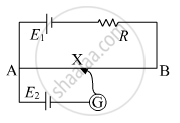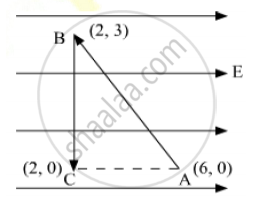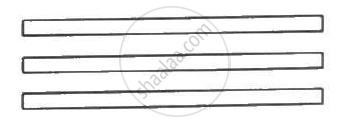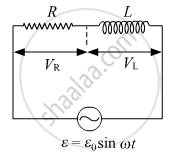Advertisements
Advertisements
Question
Two capacitors of capacitance 20⋅0 pF and 50⋅0 pF are connected in series with a 6⋅00 V battery. Find (a) the potential difference across each capacitor and (b) the energy stored in each capacitor.
Solution
Given :
`C_1 = 20.0 "pF"`
`C_2 = 50.0 "pF"`
When the capacitors are connected in series, their equivalent capacitance is given by `C_(eq) = (C_1C_2)/(C_1+C_2)`
∴ Equivalent capacitance,`C_(eq) = ((50 xx 10^-12) xx (20 xx 10^-12))/((50 xx 10^-12)+(20 xx 10^-12))` = `1.428 xx 10^-11 "F"`
(a) The charge on both capacitors is equal as they are connected in series. It is given by
`q = C_(eq) xx V`
⇒ `q = (1.428 xx 10^-11) xx 6.0 "C"`
Now ,
`V_1 = q/C_1 = ((1.428 xx 10^-11) xx 6.0 "C")/((20 xx 10^-12))`
⇒ `V_1 = 4.29 "V"`
and
`V_2 = (6.00 - 4.29) V = 1.71 "V"`
(b) The energies in the capacitors are given by
`E_1 = q^2/(2C_1)`
= `[(1.428 xx 10^-11) xx 6.0]^2` `xx 1/(2 xx 20 xx 10^-12)`
= `184 "pJ"`
and
`E_2 = q^2/(2C_1)`
= `[(1.428 xx 10^-11) xx 6.0]^2` `xx 1/(2 xx 50 xx 10^-12)`
= `73.5 "pJ"`
APPEARS IN
RELATED QUESTIONS
Define 1 volt PD.
Draw a labelled diagram of Van de Graaff generator. State its working principle to show how by introducing a small charged sphere into a larger sphere, a large amount of charge can be transferred to the outer sphere. State the use of this machine and also point out its limitations.
In the circuit diagram given below, AB is a uniform wire of resistance 15 Ω and length 1 m. It is connected to a cell E1 of emf 2V and negligible internal resistance and a resistance R. The balance point with another cell E2 of emf 75 mV is found at 30 cm from end A. Calculate the value of R.

Explain the principle of a device that can build up high voltages of the order of a few million volts.
Draw a schematic diagram and explain the working of Van de Graff generator device.
Is there any restriction on the upper limit of the high voltage set up in Van de Graff generator machine? Explain.
A test charge ‘q’ is moved without acceleration from A to C along the path from A to B and then from B to C in electric field E as shown in the figure. (i) Calculate the potential difference between A and C. (ii) At which point (of the two) is the electric potential more and why?

A 100 pF capacitor is charged to a potential difference of 24 V. It is connected to an uncharged capacitor of capacitance 20 pF. What will be the new potential difference across the 100 pF capacitor?
Find the potential difference between the points A and B and between the points B and C of the figure in steady state.

A charge of 1 µC is given to one plate of a parallel-plate capacitor of capacitance 0⋅1 µF and a charge of 2 µC is given to the other plate. Find the potential difference developed between the plates.
The capacitance between the adjacent plates shown in figure is 50 nF. A charge of 1⋅0 µC is placed on the middle plate. (a) What will be the charge on the outer surface of the upper plate? (b) Find the potential difference developed between the upper and the middle plates.

A capacitor having a capacitance of 100 µF is charged to a potential difference of 50 V. (a) What is the magnitude of the charge on each plate? (b) The charging battery is disconnected and a dielectric of dielectric constant 2⋅5 is inserted. Calculate the new potential difference between the plates. (c) What charge would have produced this potential difference in absence of the dielectric slab. (d) Find the charge induced at a surface of the dielectric slab.
What will be the potential difference in the circuit when direct current is passed through the circuit?

If a positive charge moves in the direction of the electric field ______.
On moving a charge of 20 C by 2 cm, 2 j of work is done then the potential difference between the point is:-
A bullet of mass of 2 g is having a charge of 2 µc. Through what potential difference must it be accelerated, starting from rest, to acquire a speed of 10 m/s.
Work done in moving a unit positive charge through a distance of x meter on an equipotential surface is:-
Can there be a potential difference between two adjacent conductors carrying the same charge?
